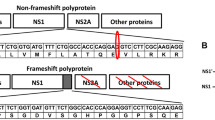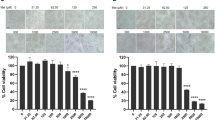Abstract
Japanese encephalitis virus (JEV) is known as an important mosquito-borne human pathogen that causes Japanese encephalitis and may lead to lethal effect. Since monocyte has been demonstrated to play transmissible role for JEV, rare study is reported to clarify the effect of JEV envelope (JEVE) protein on monocyte. This study intends to investigate the effects of JEVE protein inside monocyte. Notably, significant decreased expression of tumour necrosis factor (TNF)-α mRNA in RAW264.7 cells transfected with pEGFP-JEVE was observed as compared to those cells transfected with pEGFP. Increased p21Waf1/Cip1 protein was observed in both pEGFP and pEGFP-JEVE transfected RAW264.7 cells. However, increased p53 protein was only detected in pEGFP-transfected cells but not pEGFP-JEVE transfected cells as well as the result that no increased expression of nuclear factor-kB was observed in pEGFP-JEVE transfected cells. These experimental results indicate the effects of JEVE protein in alleviating TNF-α mRNA expression that is associated with the increased p53-independent p21Waf1/Cip1 expression and provide an explanation in the role of JEV transmission through monocyte.







Similar content being viewed by others
Abbreviations
- JEV:
-
Japanese encephalitis virus
- TNF:
-
tumour necrosis factor
- NF-kB:
-
nuclear factor-kB
References
Kitano, T., K. Suzuki, and T. Yamaguchi. 1974. Morphological, chemical, and biological characterization of Japanese encephalitis virus virion and its hemagglutinin. J. Virol. 14:631–639.
Chamber, T. J., C. S. Hahn, R. Galler, and C. M. Rice. 1990. Flavivirus genome organization, expression and replication. Annu. Rev. Microbiol. 44:649–688.
Zhang, F., Q. Huang, W. Ma, S. Jiang, Y. Fan, and H. Zhang. 2001. Amplification and cloning of the fulllength genome of Japanese encephalitis virus by a novel long RT-PCR protocol in a cosmid vector. J. Virol. Methods 96:171–182.
Umenai, T., R. Krzysko, T. A. Bektimirov, and F. A. Assaad. 1985. Japanese encephalitis: current worldwide status. Bull. World Health Organ. 63:625–631.
Takegami, T., H. Miyamoto, H. Nakamura, and K. Yasui. 1982. Biological activities of the structural proteins of Japanese encephalitis virus. Acta. Virol. 26:312–320.
McMinn, P. C.. 1997. The molecular basis of virulence of the encephalogenic flaviviruses. J. Gen. Virol. 78:2711–2722.
Mason, P. W., S. Pincus, M. J. Fournier, T. L. Mason, R. E. Shope, and E. Paoletti. 1991. Japanese encephalitis virus-vaccinia recombinants produce particulate forms of the structural membrane proteins and induce high levels of protection against lethal JEV infection. Virology 180:294–305.
Konishi, E., S. Pincus, E. Paoletti, R. E. Shope, T. Burrage, and P. W. Mason. 1992. Mice immunized with a subviral particle containing the Japanese encephalitis virus prM/M and E proteins are protected from lethal JEV infection. Virology 188:714–20.
Chen, S. O., T. J. Chang, G. Stone, C. H. Chen, and J. J. Liu. 2006. Programmed cell death induced by Japanese encephalitis virus YL vaccine strain or its recombinant envelope protein in varied cultured cells. Intervirology 49:346–351.
Yang, K. D., W. T. Yeh, R. F. Chen, H. L. Chuon, H. P. Tsai, C. W. Yao, and M. F. Shaio. 2004. A model to study neurotropism and persistency of Japanese encephalitis virus infection in human neuroblastoma cells and leukocytes. J. Gen. Virol. 85:635–642.
Ravi, V., S. Parida, A. Desai, A. Chandramuki, M. Gourie-Devi, and G. E. Grau. 1997. Correlation of tumor necrosis factor levels in the serum and cerebrospinal fluid with clinical outcome in Japanese encephalitis patients. J. Med. Virol. 51:132–136.
Shimizu, A., T. Ogata, and M. Kitaoka. 1977. Biological and immunological studies on two substrains, c-1 and c-3, derived from the Nakayama-NIH strain of Japanese encephalitis virus. Intervirology 8:52–59.
Wu, S. C., W. C. Lian, L. C. Hsu, Y. C. Wu, and M. Y. Liau. 1998. Antigenic characterization of nine wild-type Taiwanese isolates of Japanese encephalitis virus as compared with two vaccine strains. Virus Res. 55:83–91.
Bonnerot, C., D. Rocancourt, P. Briand, G. Grimber, and J. F. Nicolas. 1987. A β-galactosidase hybrid protein targeted to nuclei as a marker for developmental studies. Proc. Natl. Acad. Sci. U. S. A. 84:6795–6799.
Laemmli, U. K.. 1970. Cleavage of structural proteins during the assembly of the head of bacteriophage T4. Nature 227:680–684.
Hayden, M. S., and S. Ghosh. 2004. Signaling to NF-kB. Genes Dev. 18:2195–2224.
Bonizzi, G., and M. Karin. 2004. The two NF-kB activation pathways and their role in innate and adaptive immunity. Trends Immunol. 25:280–288.
Jimi, E., and S. Ghosh. 2005. Role of nuclear factor-kappaB in the immune system and bone. Immunol. Rev. 208:80–87.
Canman, C. E., T. M. Gilmer, S. B. Coutts, and M. B. Kastan. 1995. Growth factor modulation of p53-mediated growth arrest versus apoptosis. Genes Dev. 9:600–611.
Levine, A. J.. 1997. p53, the cellular gatekeeper for growth and division. Cell 88:323–331.
Takeda, A., and N. Takeda. 1999. Stress signal to survival and apoptosis. Ann. N. Y. Acad. Sci. 874:427–435.
Chiarugi, V., L. Magnelli, M. Cinelli, and G. Basi. 1994. Apoptosis and the cell cycle. Cell Mol. Biol. Res. 40:603–612.
Gartel, A. L., M. S. Serfas, and A. L. Tyner. 1996. p21-negative regulator of the cell cycle. Proc. Soc. Exp. Biol. Med. 213:138–149.
Cox, L. S. 1997. Multiple pathways control cell growth and transformation: overlap** and independent activities of p53 and p21Cip1/WAF1/Sdi1. J. Pathol. 183:134–140.
Gartel, A. L., and A. L. Tyner. 1998. The growth-regulatory role of p21 (WAF1/CIP1). Prog. Mol. Subcell. Biol. 20:43–71.
Figarola, J. L., N. Shanmugam, R. Natarajan, and S. Rahbar. 2007. Anti-inflammatory effects of the advanced glycation end product inhibitor LR-90 in human monocytes. Diabetes 56:647–655.
Ozato, K., H. Tsujimura, and T. Tamura. 2002. Toll-like receptor signaling and regulation of cytokine gene expression in the immune system. Biotechniques Suppl, 66–8, 70, 72 passim.
Kaisho, T., and S. Akira. 2001. Toll-like receptors and their signaling mechanism in innate immunity. Acta Odontol. Scand. 59:124–130.
Acknowledgements
This study was supported by the grant CSMU 95-OM-B-030 from Chung Shan Medical University, Taichung, Taiwan, R.O.C.
Author information
Authors and Affiliations
Corresponding author
Additional information
Huang and Tzang share equal contributions.
Rights and permissions
About this article
Cite this article
Hsu, TC., Gao, JQ., Lu, KH. et al. Japanese Encephalitis Virus Envelope Protein Mitigates TNF-α mRNA Expression in RAW264.7 Cells. Inflammation 31, 133–140 (2008). https://doi.org/10.1007/s10753-008-9058-2
Received:
Accepted:
Published:
Issue Date:
DOI: https://doi.org/10.1007/s10753-008-9058-2




